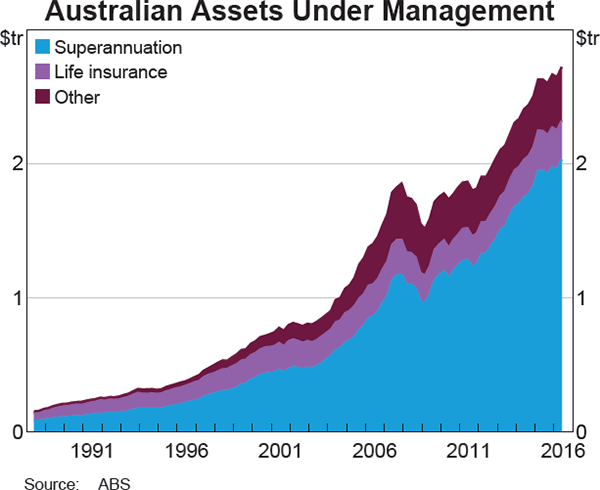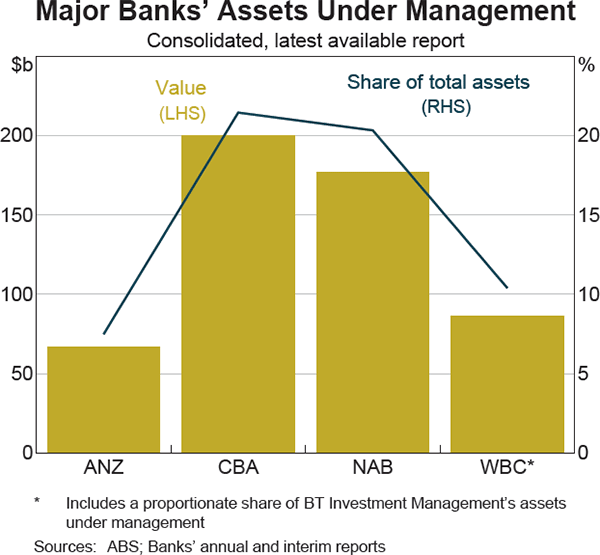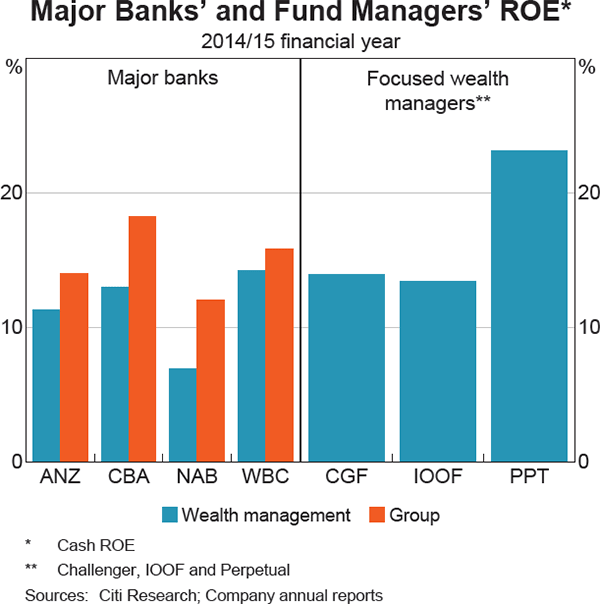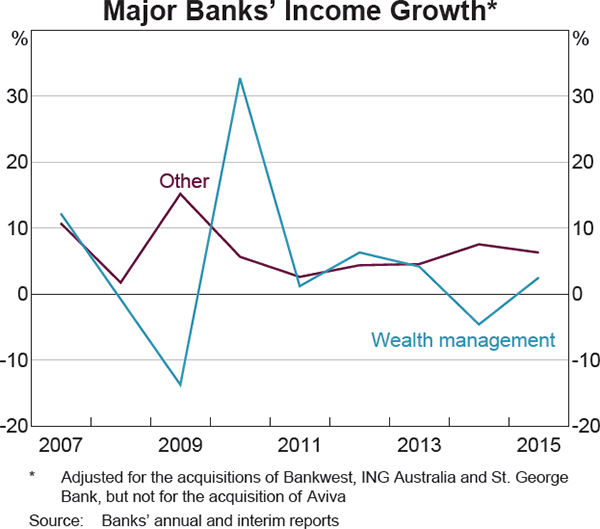Bulletin – September 2016 Financial Stability Banks' Wealth Management Activities in Australia
- Download 283KB
Abstract
Wealth management activity has grown rapidly in Australia over the past 25 years and the major banks now comprise a much larger share of the industry than they did previously. The returns on these activities across the major banks have varied, being close to those on traditional banking activities in some cases but below the cost of capital in others. By undertaking this line of business, banks have increased their resilience (by diversifying their income) but also face new risks. In part reflecting these risks, as well as a greater focus on capital management, banks have begun to re-examine the nature and extent of their involvement in wealth management.
The Wealth Management Industry in Australia
Wealth management activities account for a large part of Australia's financial system. Total assets under management (AUM) in the sector were $2.72 trillion at the end of June 2016, equivalent to around 40 per cent of financial sector assets and over 160 per cent of GDP (Graph 1). The wealth management industry has expanded rapidly over the past two decades, growing in excess of 10 per cent a year over most of this period.
Wealth management is defined here to include various forms of funds management (superannuation, managed funds and life insurance) and financial advisory services.[1] Of these, superannuation is the largest and fastest growing component, accounting for around three-quarters of AUM; the Australian superannuation system is also large by international standards, ranking fourth (relative to GDP) among Organisation for Economic Co-operation and Development (OECD) nations. Life insurance AUM have grown more slowly and now account for only a modest share of total AUM. Other AUM (such as managed funds) have grown strongly, but are currently only slightly larger than assets managed by life insurers.

One major change to the structure of the wealth management industry over the past two decades has been the growing role of the major banks in the industry.[2] Historically, wealth management services were largely provided by independent fund managers and life insurers such as AMP Limited (AMP), Colonial Group, BT Financial Group (BT) and MLC. During the late 1990s and early 2000s, each of the major banks acquired or merged with a fund manager; of the four listed above, only AMP remains independent. These acquisitions resulted in the major banks' AUM increasing from the equivalent of 13 per cent of the Australian total in the late 1990s to around one-fifth (or $530 billion) today (Graph 2). In aggregate, the major banks' AUM are equivalent to around 15 per cent of their consolidated assets. CBA currently has the largest wealth management operation relative to its other activities – AUM are equivalent to over 20 per cent of its consolidated assets – while ANZ's share is the smallest at 7 per cent. The key motivations for these acquisitions were the opportunity to cross-sell a broader range of financial services to their existing customer base and to gain exposure to the rapidly growing superannuation market.

The Structure of Banks' Wealth Management Operations
The major banks' wealth management operations are typically structured as wholly owned subsidiaries that operate as separate divisions to the more traditional banking operations.[3] Rather than consolidating their wealth management brands under their name, banks generally operate multi-brand strategies; this is possibly because of the reputations (goodwill) attached to these brands as specialised fund managers. Banks' wealth management subsidiaries are also required to have their own boards. These boards are generally separate from the parents' boards and are composed of a mix of internal staff, independent directors and executives from the parent entity.
The major banks' subsidiaries provide all stages of wealth management services: they offer financial advice, distribute products and manage funds or insurance policies on behalf of clients. The advice and distribution roles are undertaken by both the banking and wealth management divisions, while funds management is entirely contained within the latter. However, banks have begun to rethink this vertically integrated framework and in some cases have decided to partially step back by divesting majority ownership of their funds management operations, leaving the parent banks to focus on advice and distribution.[4]
In addition to the four major banks, other financial conglomerates also have a significant presence in the wealth management industry. AMP, Challenger (a non-bank) and Suncorp collectively hold around $300 billion in AUM, while Macquarie Group manages around $500 billion globally. Suncorp, Macquarie Group and AMP offer a diversified range of wealth management services similar to those offered by the major banks, while Challenger focuses on funds management. These operations differ from the wealth management divisions of major banks in that these firms have historically focused on wealth management activities (or, in the case of Macquarie Group, investment banking), rather than retail banking.
Performance
One way to examine the profitability of banks' wealth management businesses is to look at income growth. This is a relevant metric because part of the business case set out by the banks when acquiring these businesses was an expectation that the acquisitions would lead to faster income growth for the banking groups as the Australian superannuation system matured. However, wealth management income has instead grown more slowly than income from other activities since 2007 (Graph 3). A key reason for this has been that margins on these businesses (measured by revenue as a proportion of AUM) have fallen by around 20 per cent over the same period.
Competition from other superannuation funds is one reason why margins have narrowed and wealth management income has grown slower than other income over this period. The main source of competition has been industry super funds, which have consistently delivered higher returns to their customers (after fees) than retail funds, partly due to a different product mix.[5] In addition, self-managed super funds (SMSFs) have increased their market share, possibly because they offer more control than funds that are regulated by the Australian Prudential Regulation Authority (APRA). While this is likely to have affected member participation in bank-owned funds, banks have been able to generate income by providing advice on establishing and managing SMSFs, as well as lending to them. A second reason why incomes from wealth management activities have not grown more strongly has been the subdued growth in life insurance AUM and various weaknesses in historical risk management practices (including under-pricing new product features, vague definitions in contracts and poor underwriting and claims management practices; see discussion in Laughlin (2015)).

Returns on equity from the major banks' wealth management operations also appear to have been lower on average than those from their more traditional banking activities, but, in a number of cases, are still well above estimates of the banks' cost of capital. According to Citi Research estimates, the return on equity (ROE) for wealth management was a little below 15 per cent at both CBA and WBC in 2015 (Graph 4). In contrast, returns on ANZ and NAB's wealth management operations were lower.[6] ROE for specialist wealth management firms are comparable to those of CBA and WBC, suggesting that ANZ and NAB's lower returns are likely due to idiosyncratic factors such as differences in product mix. NAB in particular has a greater focus on life insurance activities where industry-wide profitability has been weak. NAB's recent sale of 80 per cent of its life insurance business to Nippon Life is expected to improve the overall returns on its wealth management business.

It is difficult to assess the extent to which banks have been able to realise the expected benefits from cross-selling opportunities associated with their wealth management activities. Research by Roy Morgan in 2014 indicated that around 10 per cent of the major banks' banking customers with wealth management products held them with the same bank. This could suggest that there are some customer retention benefits associated with their wealth management activities, but these are difficult to identify. In 2015, Roy Morgan reported that major banks had shown no significant advance over the past ten years in cross-selling wealth management products to customers. Nonetheless, it is likely that the acquisitions reduced banks' average costs by increasing the size of their distribution networks.
Benefits and Risks from Banks Involvement in Wealth Management
Financial conglomerates typically have more stable income than specialised firms because they are more diversified. There is some evidence that this makes them more resilient to shocks (e.g. Hsieh, Chen, Lee and Yang 2013). However, the consolidation of several businesses across financial industries can give rise to other risks that could offset these benefits. For example, Hoenig and Morris (2013) outline how consolidation creates larger and more complex institutions, generating additional risks as well as making it more difficult for management, boards and regulators to monitor and assess risks. Van Lelyveld and Schilder (2003), Dierick (2004), Lumpkin (2010) and APRA (2010) have also noted various potential sources of risk from large financial conglomerate structures. These benefits and risks are discussed in the remainder of this article.
Greater resilience
A more diversified source of income can increase the resilience of banking groups. A considerable body of literature exists on the diversification benefits of non-interest income for banks globally, but the findings are mixed and not always transferable across institutions (for example, Stiroh 2004 and Edirisuriya, Gunasekarage and Dempsey 2015). In Australia, the pattern of income growth for the major banks suggests that there has been some diversification benefit from their wealth management income stream, as the growth rates of their wealth management income and other income since 2007 have displayed a modest negative correlation (Graph 5). As a result, growth in banks' aggregate income has been less volatile than that of their non-wealth businesses, even though their wealth management income has been more volatile than income from other sources.
The resilience of banks could also be increased by the lower leverage associated with ownership of wealth management activities. The business of traditional banking involves a high proportion of debt funding but wealth management does not require leverage. Instead members commit equity, which is invested on their behalf, and bear the risk of any losses. As such, wealth management activities carry significantly less financial risk for the banking group and – all else being equal – may lower its overall leverage.

Increased financial risks
If large financial exposures (direct or indirect) exist between banks and their wealth management subsidiaries, there is a risk of contagion between the businesses. For example, links between the two could see losses incurred by the wealth management subsidiary ultimately being borne by the parent entity, which could affect banks' capital levels. Contagion risks could also arise if the banking group relies too heavily on funding from its wealth management subsidiary.
One growing source of intragroup funding is bank deposits sourced from superannuation funds. While it is difficult to accurately estimate the size of exposures, large superannuation funds invest almost 13 per cent of their assets in cash products, equivalent to approximately 4 per cent of all Australian banks' liabilities.[7] In addition, superannuation funds often invest heavily in fixed income and equity securities issued by the major banks. A significant fraction of these investments can be expected to be those of bank-owned funds managers in the parent bank. While it is likely that much of this exposure would exist regardless of who owns the asset management company, these exposures create a risk that the banking group may need to raise funds externally when its wealth management arm is experiencing heightened customer redemptions.
A significant deterioration in the profitability of wealth management subsidiaries could, in principle, affect the broader banking group and impede banks' ability to accumulate capital. However, income from wealth management activities only accounts for around 10 per cent of the major banks' revenues. It is therefore unlikely that a large decline in wealth management income would threaten banks' stability. Indeed, while the poor results of these subsidiaries in 2009 were viewed unfavourably by market commentators, they did not trigger concerns about the major banks' viability or long-term profitability.
Some of these financial risks are mitigated by elements of APRA's regulatory framework. For example, life insurance companies and superannuation trustees regulated by APRA are required to have risk management frameworks in place to cover all material risks to which they are exposed; there are limits on the size of exposures banks can hold against such related entities. Similarly, APRA requires banks' boards to have policies in place to manage any material risks posed to the banking groups – including those relating to liquidity and capital – arising from their financial dealings with related entities.[8] Moreover, any attempts by a bank to assist distressed wealth management subsidiaries (for example, to protect the conglomerate's brand and customer relationships) would require approval by APRA if it resulted in the bank breaching relevant prudential limits. Such approval would only be granted under exceptional circumstances.
Operational failure and resolution challenges
More complex institutions may be more likely to experience operational failures, either internally or at outsourced service providers, and these failures could affect related entities. In recognition of this, APRA has regulations in place that require APRA-regulated institutions to have adequate risk management frameworks, including for operational risk. These regulations aim to ensure that banks can continue to operate even when a service provided to the bank by their wealth management businesses is unavailable.
A bank's ownership of a wealth management business could also potentially make the institution more complex to resolve in the event of failure. APRA intends to take complexity into account when preparing resolution plans in conjunction with large institutions so that any difficulties associated with greater complexity will not materially hamper a resolution.
Governance and other strategic issues
Financial conglomerates have to consider and balance the interests of recognised stakeholders of the parent and other entities in the group. Since these interests can vary significantly and intragroup conflicts of interest may arise, there is potential for decisions to be made that are sub-optimal for particular divisions.
Banks' ownership of wealth management businesses also exposes them to financial and reputational damage in the event of misconduct within these businesses. A number of instances of misconduct have occurred in bank-owned wealth management businesses over the past couple of years. Such incidents have not been confined to bank-affiliated businesses; misconduct has also occurred at wealth management businesses that were not owned by banks. Nonetheless, banks could expose themselves to potentially significant legal, regulatory and reputational risks as a result of their ownership of wealth management businesses, which could be especially concerning if they were realised at a time when the bank was under pressure more generally. One of the most effective means of managing such risks is the development of strong risk cultures across banking groups. In recognition of this, regulators have been increasingly focusing on monitoring and improving the culture of financial firms in recent years. For example, the Chairman of APRA recently announced that both APRA and the Australian Securities and Investments Commission (ASIC) had set up teams specifically to focus on improving corporate culture. APRA has also introduced a prudential standard on risk management that requires boards to form a view of the risk culture in their firm and the adequacy of that culture in supporting risk management goals.
As a complement to such efforts to improve ethical culture, APRA has other regulations that aim to reduce the risk of poor governance. In particular, banks are required to develop and maintain integrated governance arrangements covering the banking group to which they belong. They must also ensure that material risks posed by related entities (such as wealth management businesses) to the banking group and its beneficiaries are addressed by the group's risk management framework. Wealth management businesses (besides life insurers) are not required to adhere to APRA's board composition and representation requirements. There can therefore be overlap of directors on boards of banks and their wealth management subsidiaries, but the boards of banks' wealth management businesses generally include several independent directors. Any conflicts could also be reduced by the current prudential limits on banks' financial dealings with related entities and the requirement that banks' wealth management businesses clearly disclose the banks' and other group members' roles and responsibilities to customers. In addition, a number of regulations exist that aim to reduce the risk of misconduct occurring. These include: regulations mandating clear disclosure of banks' roles and responsibilities in related non-bank businesses; comprehensive risk management frameworks for banking groups; and the Future of Financial Advice reforms, particularly the ban on conflicted remuneration structures for financial advisers and the requirement for financial advisers to act in the best interests of their clients.
Conclusion
The major banks' wealth management activities have not lived up to initial expectations for income growth and cross-selling opportunities, and are generating lower returns than core banking activities. However, these operations are, in most cases, generating returns in excess of the banks' costs of capital, and have reduced the volatility of banks' income through diversification. Ownership of these businesses exposes banks to a number of new risks, which the authorities have addressed through the regulation of these industries. In light of these developments, and the increased focus on capital requirements, banks have been rethinking the nature of their involvement in wealth management; in some cases, they have chosen to narrow the scope of their involvement in wealth management activities. Nonetheless, it appears that wealth management activities are likely to remain part of banks' businesses for the foreseeable future.
Footnotes
The author completed this work in the Financial Stability Department. This work has benefited greatly from previous internal analysis by Fiona Price. [*]
For data availability reasons, general insurance income has been included as wealth management activity in this report. [1]
Australia and New Zealand Banking Group (ANZ), Commonwealth Bank of Australia (CBA), National Australia Bank (NAB) and Westpac Banking Corporation (WBC). [2]
The main exception is WBC, which only owns 31 per cent of its associate (BT Investment Management). [3]
This includes WBC, which began divesting BT Investment Management in 2007 and sold a further portion last year, and NAB, which is in the process of transferring an 80 per cent stake in its life insurance business to Nippon Life. [4]
Rowell (2015) argues that industry funds have a much larger share of members in their default products than retail funds, whose members are often in choice products that allow the asset allocation strategies to be chosen by members. [5]
Data limitations make estimating the return on equity of individual divisions difficult, but analysts at Citi Research have provided estimates for the 2014/15 financial year by allocating equity to different divisions within banking groups using a proprietary model. [6]
‘Large’ superannuation funds exclude SMSFs and APRA-regulated funds with fewer than four members. [7]
For APRA's supervisory purposes, related wealth management entities do not form part of a banking group. [8]
References
APRA (Australian Prudential Regulation Authority) (2010), ‘Supervision of Conglomerate Groups’, APRA Discussion Paper, 18 March.
Dierick F (2004), ‘The Supervision of Mixed Financial Services Groups in Europe’, European Central Bank Occasional Paper Series No 20.
Edirisuriya P, A Gunasekarage and M Dempsey (2015), ‘Bank Diversification, Performance and Stock Market Response: Evidence from Listed Public Banks in South Asian Countries’, Journal of Asian Economics, Volume 41, pp 69–85.
Hoenig, T and C Morris (2013), ‘Restructuring the Banking System to Improve Safety and Soundness’, Unpublished manuscript, Federal Deposit Insurance Corporation and Federal Reserve Bank of Kansas City, November.
Hsieh M-F, P-F Chen, C-C Lee and S-J Yang (2013), ‘How Does Diversification Impact Bank Stability? The Role of Globalization, Regulations and Governance Environments’, Asia Pacific Journal of Financial Studies, 42, pp 813–844.
Laughlin I (2015), ‘Life Risk Insurance – A Challenge to the Life Industry: Managing for Long Term Portfolio Health’, Speech at the Actuaries Institute, Sydney, 3 March.
Lumpkin S (2010), ‘Risks in Financial Group Structures’, OECD Journal: Financial Market Trends, 2010(2), pp 105–136.
Rowell H (2015), ‘Governing Superannuation in 2015 and Beyond: Facts, Fallacies and the Future’, Speech at the AIST Governance Ideas Exchange Forum, Melbourne, 20 October.
Stiroh K (2004), ‘Diversification in Banking: Is Noninterest Income the Answer?’ Journal of Money, Credit and Banking, 36(5), pp 853–882.
van Lelyveld I and A Schilder (2003), ‘Risks in Financial Conglomerates: Management and Supervision’, Brookings-Wharton Papers on Financial Services, (2003), pp 195–224.